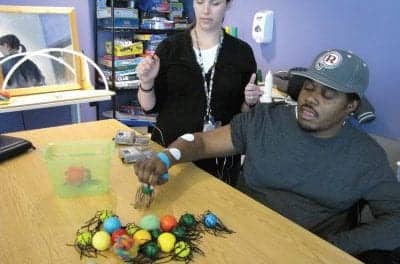A single-patient study describes the mobility results after a post-stroke patient received a surgically implanted prosthesis that was programmed to stimulate activity in the hip, knee, and ankle muscles.
According to the results, the prosthesis helped improve the patient’s walking speed and distance.
Nathaniel S. Makowski, PhD, and colleagues from the Louis Stokes Cleveland Veterans Affairs Medical Center performed the study, which was published in the American Journal of Physical Medicine & Rehabilitation, the official journal of the Association of Academic Physiatrists and published by Wolters Kluwer.
The 64-year-old patient, who had impaired motion and sensation of his left leg and foot after experiencing a hemorrhagic stroke, underwent surgery to place an implanted pulse generator and intramuscular stimulating electrodes in seven muscles of the hip, knee, and ankle, notes a media release from Wolters Kluwer Health: Lippincott Williams and Wilkins.
Makowski then created an electrical stimulation program to activate the muscles, aiming to help the patient restore a more natural gait pattern.
After the neuroprosthesis was placed, the patient experienced months of training in the researchers’ laboratory to test the results.
According to the study, the patient’s gait speed increased from 0.29 meters per second (m/s) before surgery, to 0.35 m/s after training but without muscle stimulation.
When the muscle stimulation was turned on, the patient’s gait speed increased to 0.72 m/s, and the patient showed evidence of a “more symmetrical and dynamic gait,” per the release.
The patient was also able to walk much farther post-placement. When he was first evaluated, he could walk only 76 meters before becoming fatigued. After training but without stimulation, he could walk about 300 meters (in 16 minutes). With stimulation, the patient’s maximum walking distance increased to more than 1,400 meters (in 41 minutes).
“Thus, his walking distances increased by 370% with stimulation while walking nearly twice as fast,” Makowski and colleagues write, according to the release.
The researchers note in the study that although the patient was not walking with stimulation outside the laboratory, his walking ability in daily life improved to the point of changing from “household-only” ambulation to increased time spent walking outside in the neighborhood.
“The therapeutic effect is likely a result of muscle conditioning during stimulated exercise and gait training,” the authors state in the release. “Persistent use of the device during walking may provide ongoing training that maintains both muscle conditioning and cardiovascular health.”
Makowski and colleagues stress in the release that although the results in this single-patient study are encouraging, large-scale studies will be needed to demonstrate the wider applicability of a neuroprosthesis for multi-joint control.
“Daily use of an implanted system could have significant clinical relevance to a portion of the stroke population,” they conclude in the release.
[Source(s): Wolters Kluwer Health: Lippincott Williams and Wilkins, Newswise]





